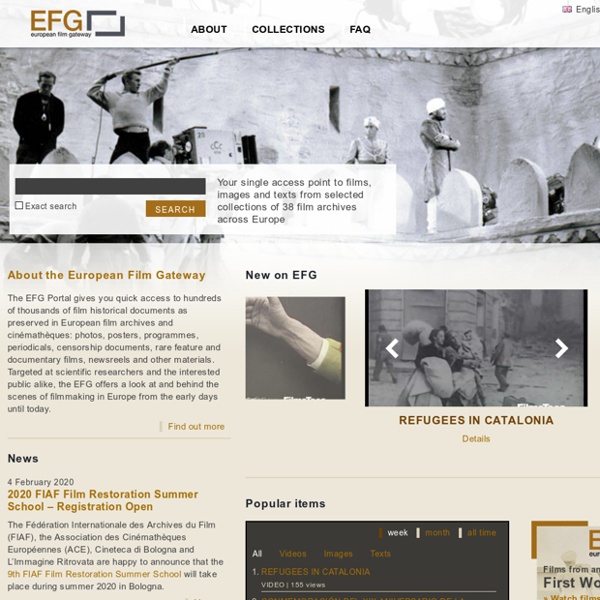



http://www.europeanfilmgateway.eu/
Related: EYE film heritageFantasia of Color in Early Cinema Les Tulipes By Giovanna Fossati, Tom Gunning and Joshua Yumibe, and Jonathon Rosen Foreword by Martin Scorsese. We normally think of early film as being black and white, but the first color cinematography appeared as early as the first decade of the twentieth century. This visually stunning book brings a treasure trove of early color film images into print form for viewers to enjoy, examine and dream over their forgotten splendor. Drawing on the early film archives of EYE Filmmuseum, the authors have carefully selected and reproduced frames from the original films made before World War I, presenting their fascinating and often surprising images and hues.
Screen Australia - Australian Productions Strictly Ballroom Mrs Carey’s Concert Toomelah House Husbands The Gradual Demise of Phillipa Finch Find information about Australian productions, and co-productions with Australia, including key cast and creatives, duration, genre, co-production partners, international sales contacts, website links and more. Mary Ellen Bute: Seeing Sound by William Moritz Mary Ellen Bute The Museum of Modern Art/Film Stills ArchiveAs with many pioneer animators, Mary Ellen Bute is hardly known today, primarily because her films are not easily available in good prints. This was not always true. During a 25-year period, from 1934 until about 1959, the 11 abstract films she made played in regular movie theaters around the country, usually as the short with a first-run prestige feature, such as Mary of Scotland, The Barretts of Wimpole Street, or Hans Christian Andersen--which means that millions saw her work, many more than most other experimental animators.The diminutive Mary Ellen grew up in Texas, and retained a soft southern accent and genteel demeanor throughout her life. She studied painting in Texas and Philadelphia, but felt frustrated by the inability to wield light in a flowing time-continuum.
The Dream of Color Music, And Machines That Made it Possible Animation World Magazine, Issue 2.1, April 1997 by William Moritz Elfriede Fischinger, Barbara Fischinger and Bill Moritz at a 1996 Lumograph performance at the Goethe Institute in Los Angeles. The dream of creating a visual music comparable to auditory music found its fulfillment in animated abstract films by artists such as Oskar Fischinger, Len Lye and Norman McLaren; but long before them, many people built instruments, usually called "color organs," that would display modulated colored light in some kind of fluid fashion comparable to music. Ancient Greek philosophers, like Aristotle and Pythagoras, speculated that there must be a correlation between the musical scale and the rainbow spectrum of hues. Thomas Wilfred with the first home Clavilux (1950.)
Film colorization This article is about colorization of monochrome moving-picture images. For colorization of still images, see Hand-colouring. Film colorization is any process that adds color to black-and-white, sepia, or other monochrome moving-picture images. Pronunciation of dogs - how to pronounce dogs correctly. This site uses Copyright © Tim Bowyer 2006-14 • All rights reserved U.S. Patent No. 20040162719 • Howjsay in: Deutsch • Français • Italiano • Español • Requests, Errata etc. The Changing Shape of Cinema: The History of Aspect Ratio Aspect Ratio is a fundamentally simple concept with a deep and important history. Simply put, the aspect ratio is the ratio of the width of the image to the height. This can be expressed as two numbers like 4×3 or 16×9 or as a decimal such as 1.85 and 2.35 – though these can be written as a ratio as in 2.35:1. But how did it all begin? Let’s turn the dial of history and look back at the very first aspect ratio of the very first motion pictures.
Emanata (Dr Ben Harvey) Preface A video of a disastrous art critique circulated on social media a while ago. (You can watch it here: strong language alert!) Georges Méliès Early life and education[edit] Plaque commemorating the site of Méliès' birth – "In this block of flats was born on the 8th of December 1861 Georges Méliès, creator of the cinematic spectacle, prestidigitator, inventor of numerous illusions" Marie-Georges-Jean Méliès was born 8 December 1861 in Paris, son of Jean-Louis-Stanislas Méliès and his Dutch wife, Johannah-Catherine Schuering.
2011 Screenings Direct/Handmade Sound programme co-curated by the Centre for Visual Music and Bath Spa University Centre for Musical Research. Rudolf Pfenninger – Barcarole. 1932, digital (originally 35mm), 8 min ..there is an ur-legend surrounding the origin of what Pfenninger called his tönende Handschrift (Sounding Handwriting)… Pfenninger seems to have been motivated less by synesthesial speculations than by economic necessity. According to the story, the poorly paid inventor Pfenninger was eager to provide a sound track for the experimental animations he was making on the side, but he could afford neither the musicians nor the studio to record them. Instead, he sat down with an oscilloscope and studied the visual patterns produced by specific sounds until he was able – sometime in late 1929 or early 1930s – to isolate a unique graphic signature for each tone.
Analog Sound - How Movie Sound Works The mechanism for delivering sound in the early days of cinema was incredibly simple. Vitaphone, used in "The Jazz Singer," consisted of a record player playing a wax record. This was known as sound-on-disc. The sound recording was usually done after the movie was filmed. The record was played on a turntable that synchronized sound to the film by controlling the speed of the projector.